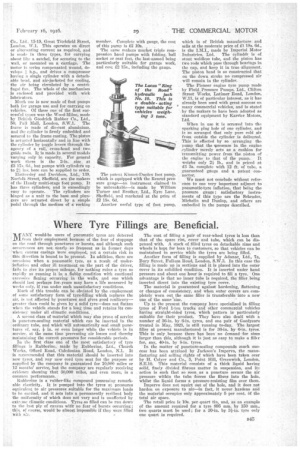Where Tyre Fillings are Beneficial.
Page 29

If you've noticed an error in this article please click here to report it so we can fix it.
TANY weuld-be users of pneumatic tyres are deterred ..LY.Lfrorn their employment because of the feat of stoppage on the road through punctures or bursts, and although such occurrences are net nearly so frequent as in former days "when canvas casings were employed, yet a certain risk in this direction is bound to be present. In addition, there are occasions when a pneumatic tyre, as a result of under. Inflation and other „ill treatment on the part of the driver, fails to give its proper mileage, for nothing ruins a tyre so rapidly as running it in a .flabby condition with continual excessive flexing occurring in the walls; and one which should last perhaps for-years may have a life measured by weeks °illy, if run under such unsatisfactory conditions.
Much of this trouble can be obviated by the employment
of some satisfactory form of tyre-filling whichthe air, is not affected by punctures and gives goo resiliency— greater than could be given by a Solid tyre--does not flatten when the vehicle Stands for a long time and retains its consistency under all climatic conditions.. . A secorid class of material which may also prove of service is puncture-sealing material which can be inserted in the eirdinary tube, and which. will automatically seal small punc
tures of, say, in. or even larger while the vehicle is in service, at the same time preventing air losses and thereby maintaining the correct pressutes for considerable periods. In the. first Class one of the most satisfactory of tyre fillings is Rubberine, made by Rubberine, Ltd., Church Works, (Mord Road, Caledonian Road, London, Ni. It is recommended that this material should be inserted into new tyres, and any new cord tyre sent for the purpose or supplied by the company is guaranteed for 10,000 miles or 12 months' service, but the company are regularly receiving evidence showing that 30,000 miles, and even more, is a common performance.
Rubberine is a 'rubber-like compound possessing remarkable elasticity. It is pumped into the tyres at pressures equivalent to air pressures suitable for the maximum loads to be carried, and it sets into a permanently resilient body the uniformity of which does not vary and is unaffected by extreme climatic conditions. Tyres so filled can be run down to the last ply of canvas with no fear of bursts occurring ; this, of course, would be almost impossible if they were filled with tile
The cost of filling a pair of rear-wheel tyres is less than that of the spare rim, cover and tube, which can be dispensed with. A stock of filled tyres on detachable rims and wheels is kept for loan to customers, so that vehicles can be maintained in service while the tyres are being filled.
Another form of filling is supplied by Adanac, Ltd., 7a, Bury Street, Fulbain Road, London, S.W.3. In this case the filling is made up in sections and it is placed into the outer cover in its solidified condition. It is inserted under hand pressure and about one hour is required to fill a tyre. One advantage is that no inner tube is required, the filler being inserted direct into the existing tyre cover_
The material is guaranteed against hardening, flattening or changes of consistency, and when outer covers are.completely worn out the same filler is transferable into a new one of the same 'size.
Up to the present the company have specialized in filling tyres of Ford 1-ton trucks and other commercial vehicles baying straight-sided tyres, which' pattern is particularly suitable for their product. They have also dealt with a number of 36-in. by 6-in. tyres, and one pair of Goodyears treated in May, 1923, is still running to-day. The largest filler at present manufactured is for 36-in. by 6-in. tyres. This is only _because there has been DO demand for sizes larger than this, although it is just as easy to make a fillir for, say, 40-in. by 8-in. tyres.
In the matter of puncture-sealing compounds much success has been attained by Jackson's Impervo, the manufacturing and selling rights of which have been taken over by H. Colyer and Co., 5, Point Bill, Greenwich, London, 5.E.10. This material consists of a thick liquid having solid, finely divided fibrous matter in suspension, and ite action is such that so soon_ as a puncture occurs the air pressure within the tube forces the fibres into the hole, whilst the liquid forms a pressure-resisting film over them.
Imperve does not squirt out of the hole, and it does not harden on exposure to air—in fact, it never hardens and the material occupies only approximately 6 per cent. Of the total air space.
The retail price is 10s. per quart tin, and, as an example elf the amount required for a tyre 895 min. by 150 mm., two quarts must be used; for a 30-in. by 3-1-in tyre only one quart is required.
































